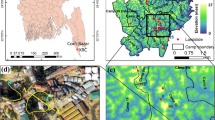Abstract
A large catastrophic landslide occurred on July 23, 2019, after a continuous heavy rainfall at Jichang (N 26°15′22.99″, E 104°40′6.33″), Shuicheng county, Guizhou province, China. This landslide had a maximum runout distance of 1295 m, a maximum falling height of 477 m between the highest point of the source area and the leading edge, and a maximum speed of 45.5 m/s. The 1.4 million cubic meters of debris instantly buried twenty-one buildings, destroyed six buildings, and resulted in 42 fatalities and 9 people missing. This paper analyzes the extent and mechanisms of initiation and runout distance of the landslide. The landslide occurred in the eluvial and deluvial accumulation of basalt, and its initiation mechanisms were different from the bedrock landslides that are typical of the interbedded soft and hard rocks in Guizhou and basalt landslides in Southwest China. The prolonged heavy rainfall, lush vegetation, and road construction played the roles in landslide initiation. Subsequently, the landslide can be divided into three sliding regions caused by the valley on both sides and the stepped terrain in the middle, and the valley topography enhanced the disaster intensity and reach.













Similar content being viewed by others
References
Corominas J (1996) The angle of reach as a mobility index for small and large landslides. Can Geotech J 33(2):260–271. https://doi.org/10.1139/t96-005
Daudon D, Villard P, Richefeu V, Mollon G (2015) Influence of the morphology of slope and blocks on the energy dissipations in a rock avalanche. Comptes Rendus Mecanique 343:166–177. https://doi.org/10.1016/j.crme.2014.11.003
Fan XY, Li TH, Tian SJ, Zhang YY, Sun XP (2017) Controlling factors and mechanisms of incomplete obstruction seismic landslide mobility. Seismol Geol 39(4):754–767 (in Chinese)
Fan XM, Xu Q, Scaringi G, Zheng G, Huang RQ, Dai LX, Ju YZ (2019) The“long” runout rock avalanche in Pusa, China, on August 28, 2017: a preliminary report. Landslides 16:139–154. https://doi.org/10.1007/s10346-018-1084-z
Gao Y, Yin YP, Li B, Feng Z, Wang WP, Zhang N, Xing AG (2017) Characteristics and numerical runout modeling of the heavy rainfall-induced catastrophic landslide–debris flow at Sanxicun, Dujiangyan, China, following the Wenchuan Ms 8.0 earthquake. Landslides 14:1361–1374. https://doi.org/10.1007/s10346-016-0793-4
He SM, Liu W, Wang J (2015) Dynamic simulation of landslide based on thermo-poro-elastic approach. Comput Geosci 75:24–32. https://doi.org/10.1016/j.cageo.2014.10.013
Huang RQ, Xu Q (2008) Catastrophic landslides in China. Science Press, Beijing (in Chinese)
Iverson RM, George DL (2016) Modeling landslide liquefaction, mobility bifurcation and the dynamics of the 2014 Oso disaster. Geotechnique 66:175–187. https://doi.org/10.1680/jgeot.15.LM.004
Legros F (2002) The mobility of long-runout landslides. Eng Geol 63:301–331
Li W, Xu Q, Wu LZ, Li SQ (2018) Influence of seepage forms of confined water on translational landslide. Rock Soil Mech 39(4):1401–1410 (in Chinese)
Lin F, Wu LZ, Huang RQ, Zhang H (2018) Formation and characteristics of the Xiaoba landslide in Fuquan, Guizhou, China. Landslides 15:669–681. https://doi.org/10.1007/s10346-017-0897-5
Manzella I, Labiouse V (2009) Flow experiments with gravel and blocks at small scale to investigate parameters and mechanisms involved in rock avalanches. Eng Geol 109:146–158. https://doi.org/10.1016/j.enggeo.2008.11.006
Nicoletti PG, Sorriso-valvo M (1991) Geomorphic controls of the shape and mobility of rock avalanches. Geol Soc Am Bull 103:1365–1373
Qi SW, Xu Q, Zhang GB, Zhou YD, Lan HX, Li LH (2011) Source characteristics of long runout rock avalanches triggered by the 2008 Wenchuan earthquake, China. J Asian Earth Sci 40:896–906. https://doi.org/10.1016/j.jseaes.2010.05.010
Scaringi G, Fan XM, Xu Q, Liu C, Ouyang CJ, Domènech G, Yang F, Dai LX (2018) Some considerations on the use of numerical methods to simulate past landslides and possible new failures: the case of the recent Xinmo landslide (Sichuan, China). Landslides 15:1359–1375. https://doi.org/10.1007/s10346-018-0953-9
Scheidegger AE (1973) On the prediction of the reach and velocity of catastrophic landslides. Rock Mech 5(4):231–236
Sheng LT, Tai YC, Kuo CY, Hsiau SS (2013) A two-phase model for dry density-varying granular flows. Adv Powder Technol 24:132–142. https://doi.org/10.1016/j.apt.2012.04.001
Wang GH, Huang RQ, Sérgio DN, Lourenço TK (2014) A large landslide triggered by the 2008 Wenchuan (M8.0) earthquake in Donghekou area: phenomena and mechanisms. Eng Geol 182:148–157. https://doi.org/10.1016/j.enggeo.2014.07.013
Xu Q, Fan XM, Dong XJ (2012) Characteristics and formation mechanism of a catastrophic rainfall-induced rock avalanche-mud flow in Sichuan, China, 2010. Landslides 9:143–154. https://doi.org/10.1007/s10346-011-0278-4
Yang HQ, Lan YF, Lu L, Zhou XP (2015) A quasi-three-dimensional spring-deformable-block model for runout analysis of rapid landslide motion. Eng Geol 185:20–32. https://doi.org/10.1016/j.enggeo.2014.11.016
Yin YP (2013) Approaches to landslide risk assessment in China-long runout and catastrophic landslides study in Tibet and seismic landslide hazards mapping in Sichuan, China. Landslides: Global Risk Preparedness 8:115–131. https://doi.org/10.1007/978-3-642-22087-6-8
Yin YP, Sun P, Zhu JL, Yang SY (2011) Research on catastrophic rock avalanche at Guanling, Guizhou, China. Landslides 8(4):517–525. https://doi.org/10.1007/s10346-011-0266-8
Yin YP, Xing AG, Wang GH, Feng Z, Li B, Jiang Y (2017) Experimental and numerical investigations of a catastrophic long-runout landslide in Zhenxiong, Yunnan, southwestern China. Landslides 14:649–659. https://doi.org/10.1007/s10346-016-0729-z
Zhang M, Yin YP (2013) Dynamics, mobility-controlling factors and transport mechanisms of rapid long-runout rock avalanches in China. Eng Geol 167:37–58. https://doi.org/10.1016/j.enggeo.2013.10.010
Zhao JJ, Xiao J, Lee ML, Ma YT (2016) Discrete element modeling of a mining-induced rock slide. SpringerPlus 5:1633–1651. https://doi.org/10.1186/s40064-016-3305-z
Acknowledgments
We thank Prof. Siming He from the Institute of Mountain Hazards and Environment (IMHE), Chinese Academy of Sciences (CAS), for the images taken with the unmanned aerial vehicles and topographic post-landslide map.
Funding
This research was financially supported by the National Science Fund of China (Grant No. 41877524, 41971214), the National Key Research and Development Program of China (Grant No. 2018YFC1505401), the Opening Fund of Shock and Vibration of Engineering Materials, and Structures Key Laboratory of Sichuan Province (Grant No. 18kfgk10), the Strategic Priority Research Program of Chinese Academy of Sciences (XDA 23090202), the National Natural Science Foundation of China (Grant No. 41761144077), and the CAS Pioneer Hundred Talents Program (Jiang Yuanjun).
Author information
Authors and Affiliations
Corresponding author
Rights and permissions
About this article
Cite this article
Fan, X., Tang, J., Tian, S. et al. Rainfall-induced rapid and long-runout catastrophic landslide on July 23, 2019 in Shuicheng, Guizhou, China. Landslides 17, 2161–2171 (2020). https://doi.org/10.1007/s10346-020-01454-y
Received:
Accepted:
Published:
Issue Date:
DOI: https://doi.org/10.1007/s10346-020-01454-y




